Woolworth Building Tour & Reception: From Cathedral of Commerce to Catalyst for Culture
Join us for a special evening celebrating an exciting new chapter in one of New York City’s most legendary landmarks!


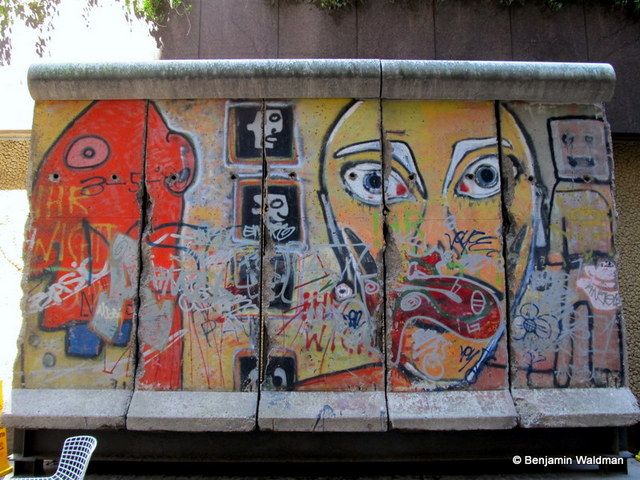
The Berlin Wall…in New York City? You heard that right. And there’s not just one piece, but five. In the early 1980s, artist Thierry Noir began painting the surfaces on the west side of the Berlin Wall, close to his apartment. In an effort to make the wall seem less menacing, other artists joined in, covering various sections of the wall with painted figures and graffiti. The 14-foot tall wall became a huge canvas, giving voice to artists from around the world, and a popular tourist destination.
The dismantling of the Wall was completed in 1991, with more than 40,000 wall sections recycled into building materials used for German reconstruction projects. However a few hundred sections were preserved, sold, auctioned off or given away. Five of these sections are here in New York City. While we previously published this article in 2015, we’re updating it with the latest information on the 30th anniversary of the fall of the Berlin Wall on November 10th, 1989.
A documentary “The American Sector” is releasing soon, which traces an effort to track down the Berlin Wall segments that are in the United States. According to the director of a government think tank in Germany, only 650 pieces are known to exist out of an estimated 88,000 original panels.
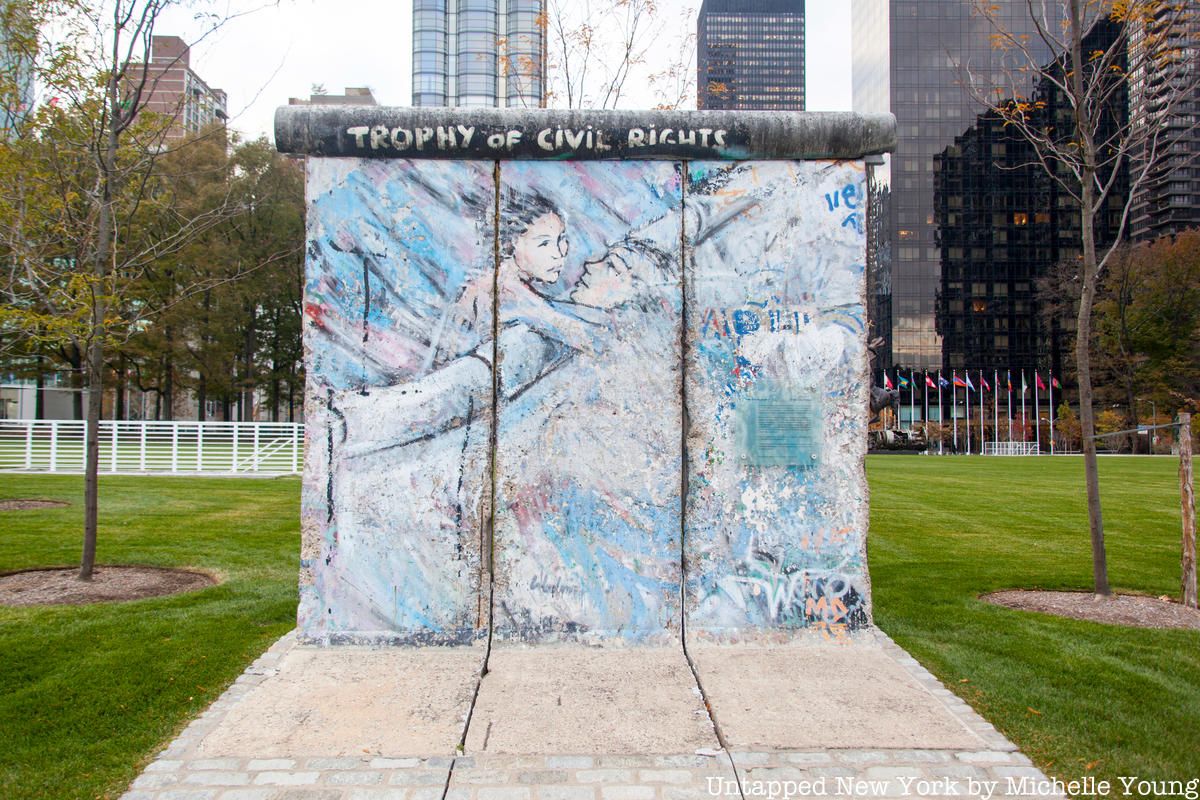
The Berlin Wall piece from Potzdamer Platz that stands in the United Nations Sculpture Garden, which contains gifts from many member countries of the UN, and this three-slab section was gifted from Germany in 2002, presented by the President of the German Bundestag, Wolfgang Thierse to then-UN Secretary General Kofi Annan.
At the ceremony, Annan said, “The Berlin Wall was an offence to the human spirit. It not only marked the division of Germany and Europe, but also expressed, in a uniquely horrible way, the propensity of human beings to erect walls and borders, and then glare across them, hearts filled with hate, minds full of fear and distrust, all the while numb to the notion that there might be a better way.”
The Berlin Wall section is painted on both sides. The side facing the East River is entitled Trophy of Civil Rights and depicts two people reaching over the top of the wall to embrace each other. It is believed that this painting was made between 1989 and 1990, following the fall of the Berlin Wall. The other side of the wall, facing 1st Avenue, is a graffiti work made German artist Kani Alavi, who has painted other sections along the wall’s East Side Gallery as one of the leaders of the initiative to retain the remnant section of the wall as an open-air gallery.
While the United Nations Sculpture Garden was previously off-limits to the public, an attempt to raise awareness about an forgotten Eleanor Roosevelt monument inside has led to the opening of the garden on select times for tours that happen each summer.
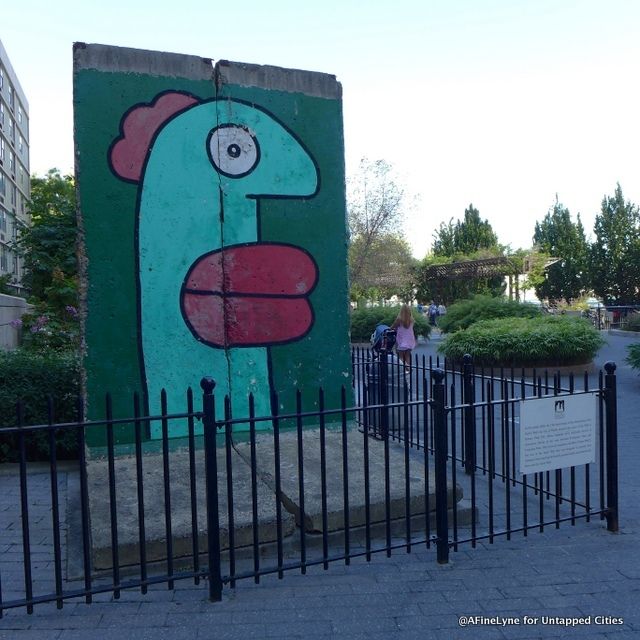
A concert by the Julliard School Conservatory of Music and the Hochschule für Musik Hanns Eisler Berlin took place in Battery Park City in 2004, overlooking the Statue of Liberty and billed as a friendship concert. It was on this occasion, which was also the 15th anniversary of the fall of the Berlin Wall, that these two wall slabs were gifted and given a permanent home on the Kowsky Plaza at The Battery. The 12′ high by 8′ wide pieces once stood between Potsdamer Platz and Leipzig Platz. They now sit directly in front of Saint Joseph’s Chapel in the North Cove.
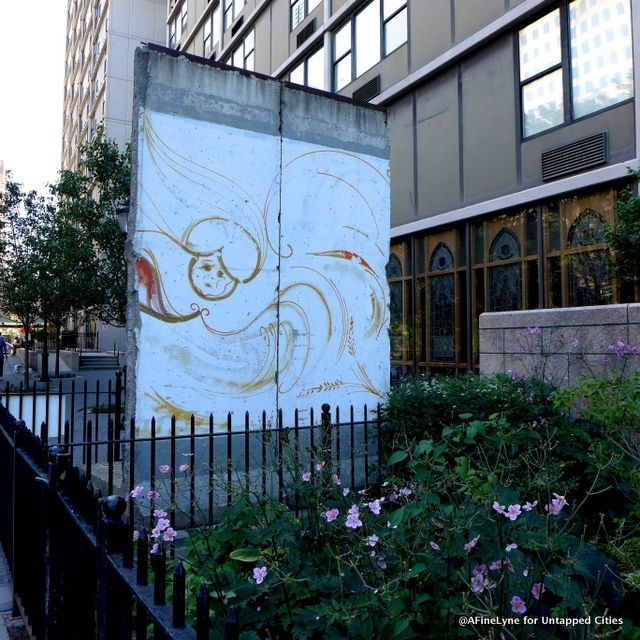
Artist Kiddy Citny, who often painted with Thierry Noir
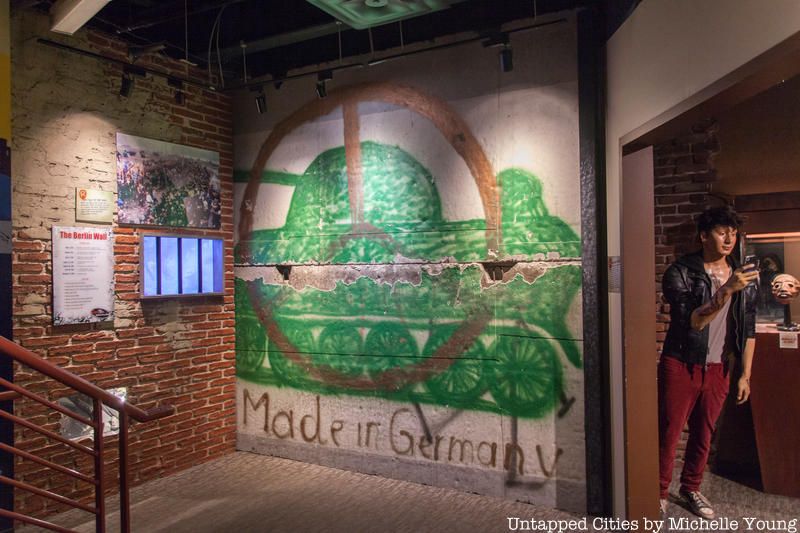 Originally at Waldemarstrasse in Berlin
Originally at Waldemarstrasse in Berlin
Believe it or not, this historic slab of the Berlin Wall is located at Ripley’s Believe it or Not in Times Square. 160 feet of the Berlin Wall was acquired by Ripley’s former Vice President of Exhibits and Archives, Edward Meyer shortly after the wall fell. He was in Berlin when the wall came down and bought the pieces on site. This amounted to 16 ten-foot sections at a total weight of 40,000 pounds.
The Ripley Collection of the Berlin Wall was distributed to their many museums throughout the world. On the company website, Ripley’s explains how the pieces got to the United States: “They had to be moved 200 miles by barge from Berlin to Hamburg, and then shipped via ocean freighter across the Atlantic to New Orleans before being trucked to our headquarters in Orlando. Though we arrived three days after the fall, it took over a year to get the pieces back to America.” The historic slab pictured above, originally located at Waldemarstrasse in Berlin can be found at Ripley’s Times Square location at 234 West 42nd Street.
 520 Madison Avenue
520 Madison Avenue
In 1990, Jerry Speyer of Tishman Speyer purchased a piece of the Berlin Wall from the East German government. It was originally installed next to the popular Paley Park, situated on 53rd Street near Madison Avenue. The five colorful panels that make up this part of the Berlin Wall were visible from the sidewalk until 2014 when they vanished. They reappeared in the lobby of 520 Madison Avenue, in an effort to preserve the historic slabs from weather and further decay, but have since disappeared again.
This particular piece is what gave the forthcoming documentary “The American Sector” its biggest pause. This was the piece director Pacho Velez passed by regularly, but he wasn’t able to locate it. According to a Wall Street Journal article from this week, a real estate company spokesperson said it was moved from the lobby and is in storage. We have reached out to Tishman Speyer for an answer on if or when it will return.
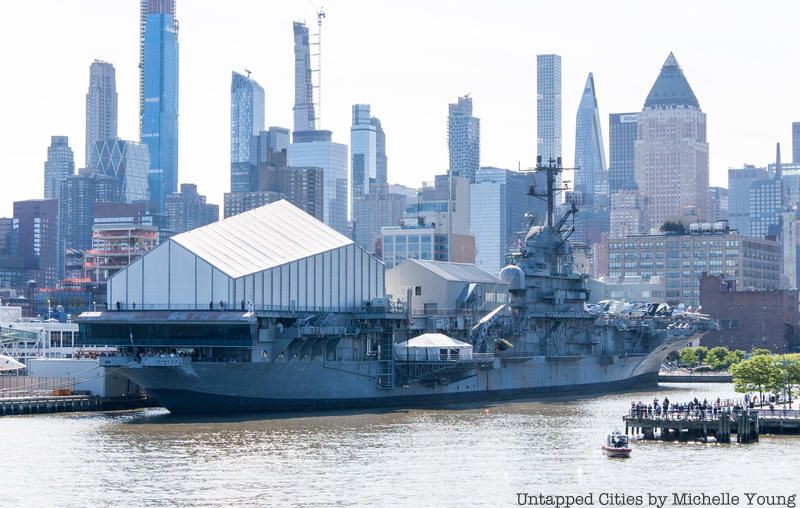
This 7,000 pound portion of the Berlin Wall, painted by Kiddy Citny–was given to artist Peter Max in 1989. It was originally located on Waldemarstrasse in Berlin Kreuzberg. Using a hammer and chisel, Max carved a dove from within the stone and placed it on the top of the wall –as if to set it free. He then had it installed on the grounds of the Intrepid Sea, Air & Space Museum at Pier 86, where it stood for many years until the Intrepid was removed for renovation, while another piece went to the Marbles Kids Museum in Raleigh, North Carolina. We were told by the Intrepid Museum that this historic slab was a temporary exhibit and returned to the lender over a decade ago.
Next, read about 10 indoor public places in NYC for your very own urban oasis and 13 of the best pocket parks in NYC.
Subscribe to our newsletter